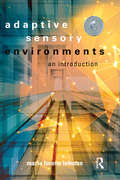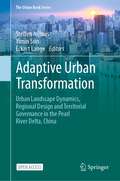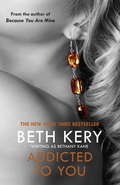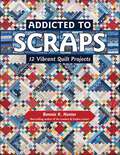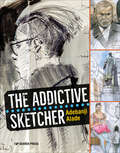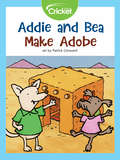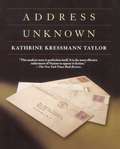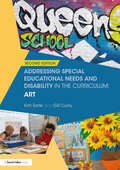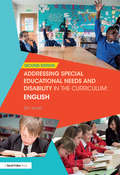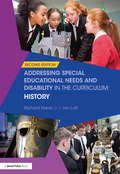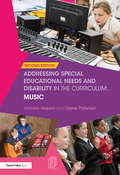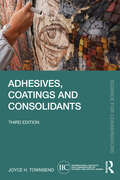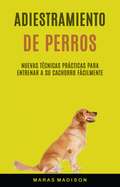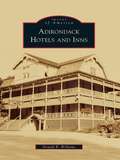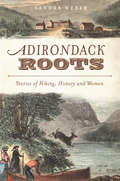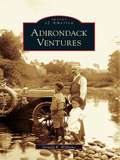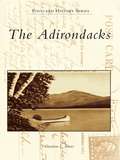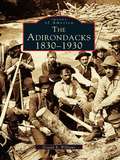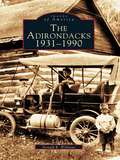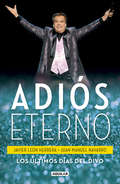- Table View
- List View
Adaptive Sensory Environments: An Introduction
by Maria Lorena Lehman***WINNER OF A NAUTILUS 2017 SILVER MEDAL BOOK AWARD*** Adaptive Sensory Environments: An Introduction presents a cutting-edge methodology for adaptive sensory design by fostering an inter-disciplinary approach in which aspects of neuroscience, biophilia, captology, nanotechnology, kinetics, and sensemaking all play critical roles in helping adaptive architecture "tune" to occupants. Furthermore, the book illustrates how adaptive sensory environments transform and uplift quality of life in entirely new ways, by strategically unlocking the potential that technological innovations bring. By teaching scholars, researchers, practitioners, specialists, and consultants how to design architecture that guides what emerging interactive technology can do, it allows them to see deeper into an architectural design, to extend beyond interaction and, ultimately, to build environments that adapt by changing and growing with their occupants’ immediate needs and long-term goals.
Adaptive Thermal Comfort of Indoor Environment for Residential Buildings: Efficient Strategy for Saving Energy (SpringerBriefs in Architectural Design and Technology)
by Carlos Rubio-Bellido David Bienvenido-HuertasThis book is structured in four parts: First, it analyzes the sustainability objectives established for the building stock and the importance of thermal comfort in this aspect. Second, the existing adaptive thermal comfort models and the main energy-saving measures associated with these models are analyzed. Third, the energy savings obtained with these measures are analyzed in several case studies, comparing the results obtained with other energy conservation measures, such as the improvement of the façade. The analysis is carried out from an energy and economic perspective. Finally, a decision‐making process based on fuzzy logic is established. As an expected result, the content of the book contributes to assist architects in designing more efficient buildings from the perspective of user behavior.
Adaptive Urban Transformation: Urban Landscape Dynamics, Regional Design and Territorial Governance in the Pearl River Delta, China (The Urban Book Series)
by Steffen Nijhuis Eckart Lange Yimin SunThis open access book provides a cross-sectoral, integrative and multi-scale design and planning approach for adaptive urban transformation of fast urbanising deltas, taking the Pearl River Delta (China) as a case study. Deltaic areas are among the most promising regions in the world. Their strategic location and superior quality of their soils are core factors supporting both human development and the rise of these regions as global economic hubs. At the same time, however, deltas are extremely vulnerable to multiple threats from both climate change and urbanisation. These include an increased flood risk combined with the resulting loss of ecological and social-cultural values. To ensure a more sustainable future for these areas, spatial strategies are needed to strengthen resilience, i.e. help the systems to cope with their vulnerabilities as well as enhance their capacity to overcome natural and artificial threats.The book provides a unique approach that integrates research in urban landscape systems, territorial governance and visualisation techniques that will help to achieve more integrated and resilient deltas. Based on an assessment of the dynamics of change regarding the transformational cycles of natural and urban landscape elements, eco-dynamic regional design strategies are explored to reveal greater opportunities for the exploitation of natural and social-cultural factors within the processes of urban development.
Addestramento dei Cani: I migliori Consigli e Trucchi per l'Addestramento del Vostro Cucciolo
by John BurkeAddestramento dei cani: I migliori consigli e trucchi per l'addestramento dei cuccioli di John Burke I migliori consigli e trucchi per l'addestramento del vostro cucciolo Troverete questa guida molto utile e completa, essenziale per assicurare che la transizione per voi e la vostra famiglia e per il nuovo cucciolo Beagle sia il più possibile positiva e di successo. Imparerete tutto ciò che c'è da sapere per essere ben preparati, cominciando da quali provviste avrete bisogno a come rendere a prova di cucciolo la vostra casa di modo che il vostro Beagle sia sicuro, fino all'addestramento del vasino, quali alimenti dargli ed in quanta quantità, consigli per il bagno, pro e contro dell'assicurazione del cucciolo ed altro ancora. I cuccioli di Sheltie ed i cani adulti possono godere di risultati rapidi nell'addestramento dei cani. Il nostro scopo è quello di offrire a voi ed al vostro nuovo cucciolo o cane il miglior sistema di addestramento per cani Sheltie. Siamo seri riguardo ai vostri risultati e durante il processo di addestramento di Sheltie potreste divertirvi utilizzando il nostro nuovo e migliorato sistema di addestramento specifico per cani di razza Sheltie. Ecco esattamente come addestrare il vostro cucciolo Sheltie ed anche i cani adulti. Il tutto è pronto per voi in questo momento in una guida all'addestramento dei cani in modo semplice, divertente, breve, veloce ed altamente efficace. Se siete pronti ad agire ed a cambiare la vostra vita in meglio, questo libro vi guiderà sicuramente nella giusta direzione!
Addestramento del cane: la guida definitiva passo passo
by Samantha KaneSe stai portando a casa il tuo primo cane questo libro ti sarà di grande aiuto, perché sono certa che vorrai avere il cane più educato del mondo e vorrai essere il miglior padrone per il nuovo membro della tua famiglia. Questo libro è stato progettato per insegnarti a comunicare con il tuo cane in modo corretto ed efficace. A quel punto, dato che gli è stato permesso di saltare addosso, è davvero difficile insegnargli il contrario. Ho perso il conto di quante volte, vestita di tutto punto per qualche evento, sono passata a casa di amici e mi sono ritrovata seduta su una sedia ricoperta di pelo di cane. È qui che l’addestramento del cane all’obbedienza entra in gioco. Non vorresti dover fermare il tuo cucciolo che sta ringhiando per una ragione legittima. Se il ringhio è appena iniziato, chiediti quali cambiamenti sono accaduti nella sua vita, ad esempio nel suo addestramento o nella vita di casa. Potrebbe dipendere da qualche problema fisico che deve essere controllato dal veterinario. Se sei pronto ad agire e cambiare la tua vita in meglio, questo libro ti guiderà sicuramente nella giusta direzione!
Addicted To You: One Night of Passion Book 1 (One Night of Passion)
by Beth KeryFrom the New York Times ebook bestselling author of the Because You Are Mine series and The Affair, for fans for Sylvia Day, J. Kenner and Maya Banks. This is the first in Beth Kery's One Night of Passion series about a group of connected characters who each begin their romance with a night of impulsive, steamy sex...Irish film director Rill Pierce fled to the tiny, backwoods town of Vulture's Canyon, seeking sanctuary and solitude after a devastating tragedy. Once, his raw sex appeal and sultry Irish accent made women across the globe swoon. Now, he's barely recognisable... But Katie Hughes, his best friend's sister, is not the type of woman to give up on a man like Rill. She blazes into Vulture's Canyon determined to save him from himself. Instead, she finds herself unleashing years of pent-up passion. In a storm of hunger and need, Katie and Rill forget themselves and the world. But will Rill's insatiable attraction to Katie heal his pain - or will it just feed the darkness within him?***This was previously published under the author's pseudonym Bethany Kane***Lose yourself in One Night of Passion: Addicted To You, Bound To You, Captured By You, Exposed To You, Only For You.
Addicted to Scraps: 12 Vibrant Quilt Projects
by Bonnie K. HunterScrap it up! Don't crumble under the weight of your scraps—embrace them with best-selling author, Quiltmaker columnist, and esteemed teacher Bonnie K. Hunter. Piece 12 unique, multicolored scrap quilts in Bonnie's signature style. Turn leftover strips into usable fabric that's readily available for projects with the easy-to-use Scrap User's System. This complete guide to scrap quilting includes full-size templates, 2 paper-piecing patterns, and a full chapter on quiltmaking basics. - Forever change the way you look at scraps! 12 versatile quilt patterns for scrap addicts - Savor scraps of all shapes and sizes with best-selling author and Quiltville teacher Bonnie K. Hunter - Make fabric strips usable again with Bonnie's popular best storage tips and practices
Addictive Sketcher
by Adebanji AladeGiving an insight into how this inspiring and talented artist works, The Addictive Sketcher passes on Adebanji Alade's infectious enthusiasm and will have the reader reaching for a pencil or pen to have a go. Adebanji has a skill and a passion for speaking and motivating his audience in a fun and engaging way, and this is reflected in his writing style. Lively, stimulating and instructive, it is packed with numerous examples of the author’s sketches as well as examples of his vibrant finished paintings. Covering pencils, coloured pencils, charcoal and graphite, along with finished oil paintings, this book provides a fascinating insight into the author’s techniques. Adebanji’s work covers a broad range of subjects, including landscapes, portraits, crowd scenes, urban scenes and seascapes. He’s particularly well known for his portraits and working outdoors capturing the life of London where he lives. This book includes examples from a range of subject areas.
Addie and Bea Make Adobe
by Amy TaoAddie and Bea use the perfect material to build a house in the desert—adobe!
Address Unknown
by Kathrine Kressmann TaylorA rediscovered classic, originally published in 1938 --and now an international bestseller. When it first appeared in Story magazine in 1938, Address Unknown became an immediate social phenomenon and literary sensation. Published in book form a year later and banned in Nazi Germany, it garnered high praise in the United States and much of Europe. A series of fictional letters between a Jewish art dealer living in San Francisco and his former business partner, who has returned to Germany, Address Unknown is a haunting tale of enormous and enduring impact.
Addressing Challenges in Evaluating School Principal Improvement Efforts
by Laura S. Hamilton Susan M. Gates Susan Burkhauser Ashley PiersonGiven the focus on accountability in education, stakeholders are interested in evaluating whether efforts aimed at improving school leadership show results; the key criteria are student outcomes. This report describes challenges that states, districts, and other entities can expect to encounter as they evaluate efforts targeting school leadership as a way to improve student outcomes and offers suggestions for dealing with those challenges.
Addressing Special Educational Needs and Disability in the Curriculum: Art (Addressing SEND in the Curriculum)
by Kim Earle Gill CurryThe SEND Code of Practice (2015) reinforced the requirement that all teachers must meet the needs of all learners. This topical book provides practical, tried and tested strategies and resources that will support teachers in making art lessons accessible and interesting for all pupils, including those with special needs. The authors draw on a wealth of experience to share their understanding of special educational needs and disabilities and show how the art teacher can reduce or remove any barriers to learning. Offering strategies that are specific to the context of art teaching, this book will enable teachers to: develop students’ understanding, appreciation and enjoyment of art and design; advance students’ sense of enquiry about visual and tactile experiences; help pupils to realise their creative intentions, through the development of technical competence and manipulative skills; provide opportunities for personal and imaginative enquiry; sample a variety of art and design projects to use in their own lessons; plan the classroom layout and display to enhance learning; successfully train, and fully use the support of, their teaching assistants. An invaluable tool for continuing professional development, this text will be essential for secondary art teachers (and their teaching assistants) seeking guidance specific to teaching art to all pupils, regardless of their individual needs. The book will also be of interest to secondary SENCOs, senior management teams and ITT providers. Full of practical ideas and inspiration, and supported by free online resources, this is an essential tool for art teachers and teaching assistants and will help to deliver successful, inclusive lessons for all pupils.
Addressing Special Educational Needs and Disability in the Curriculum: English (Addressing SEND in the Curriculum)
by Tim HurstThis book provides practical strategies and resources that have been proven effective in teaching English to pupils of all abilities, making English accessible, challenging and exciting. The author outlines important key principles that should underpin teaching and learning so that all pupils, including those with special educational needs, can enjoy the subject and make outstanding progress. The ideas and guidance draw on a wealth of experience, providing classroom activities and free online resources, which can be combined with different teaching approaches. A range of appendices provides teachers with real-life case studies and examples and templates for supporting pupils with SEND. Offering strategies that are specific to the context of English teaching, this book will enable teachers and their teaching assistants to: develop pupils’ understanding by engaging multi-sensory approaches; ensure all pupils are able to participate fully in lessons and achieve success; design and use individual plans for pupils with SEND; assess and adapt content and resources when differentiating materials for pupils with a wide range of learning needs; use formative assessments to measure learning and inform planning. An invaluable tool for whole-school continuing professional development, this fully revised text will be essential for teachers and their teaching assistants seeking guidance specific to teaching English to all pupils, regardless of their individual needs. This book will also be of interest to SENDCOs, learning support units and senior management teams as well as to teacher-training professionals.
Addressing Special Educational Needs and Disability in the Curriculum: History (Addressing SEND in the Curriculum)
by Richard Harris Ian LuffThe SEND Code of Practice (2015) has reinforced the requirement that all teachers must meet the needs of all learners. This topical book provides practical, tried and tested strategies and resources that will support teachers in making history lessons accessible and exciting for all pupils, including those with special needs. The authors draw on a wealth of experience to share their understanding of special educational needs and disabilities and show how the history teacher can reduce or remove any barriers to learning. Offering strategies that are specific to the context of history teaching, this fully revised edition will enable teachers to: Make history education accessible and engaging to pupils of all abilities Create an inclusive classroom environment that responds to the emotional needs of the class and nurtures a culture of learning Develop inclusive practical demonstration and role play techniques to aid conceptual understanding Set assessment objectives Deploy in-class support effectively An invaluable tool for continuing professional development, this text will be essential for teachers (and their teaching assistants) seeking guidance specific to teaching history to all pupils, regardless of their individual needs. This book will also be of interest to SENDCOs, senior management teams and ITT providers. In addition to practical activities and supporting material contained in the book, there are also free online resources for readers to download and use in the preparation of successful, inclusive lessons for all pupils.
Addressing Special Educational Needs and Disability in the Curriculum: Music (Addressing SEND in the Curriculum)
by Diane Paterson Victoria JaquissThe SEND Code of Practice (2015) has reinforced the requirement that all teachers must meet the needs of all learners. This topical book provides practical, tried and tested strategies and resources that will support teachers in making music lessons accessible and exciting for all pupils, including those with special needs. The authors draw on a wealth of experience to share their understanding of special educational needs and disabilities and show how the music teacher can reduce or remove any barriers to learning. Offering strategies that are specific to the context of music teaching, this book will enable teachers to: ensure all pupils are able to enjoy and appreciate music; find the appropriate musical instruments to suit the individual learner; develop approaches for teaching composition in mixed ability classrooms; provide opportunities for different types of performance; adapt content, approaches and resources for pupils with a wide range of learning needs. An invaluable tool for continuing professional development, this text will be essential for teachers (and their teaching assistants) seeking guidance specific to teaching music to all pupils, regardless of their individual needs. This book will also be of interest to SENCOs, senior management teams and ITT providers. In addition to free online resources, a range of appendices provides music teachers with lesson case studies, behaviour plans and guidance on behaviour management and effective teaching. This is an essential tool for music teachers and teaching assistants, and will help to deliver successful inclusive lessons for all pupils.
Adhesives, Coatings and Consolidants (Science for Conservators)
by Joyce H. TownsendThis new edition titled Adhesives, Coatings and Consolidants discusses the chemical, physical, and optical properties that influence the selection of adhesives, coatings, and consolidants used in the conservation of cultural heritage objects made from a wide range of materials.The structured text guides readers through the concepts that underpin the selection of the material to use for a given object, when making a join, applying a coating, or consolidating a fragile surface. Widely used conservation materials today are mentioned in the context of the desirable properties that account for their popularity, while examples of those used in the past and likely to be found on previously treated objects are also discussed. This volume is not a recipe book. It is a basic primer and an aid to the assimilation of concepts that will become embedded in decision-making by conservation professionals. Adhesives are discussed first and in the most detail, followed by coatings. The section on consolidants has been extended to reflect developments in treatment and ongoing research into more effective and more sustainable products, such as nanomaterials, that offer new possibilities for the treatment of challenging objects. A list of further reading and some practical exercises are included, along with a comprehensive index.Thoroughly updated to reflect the most recent research, Adhesives, Coatings and Consolidants remains a crucial resource for those beginning a course of study in practical conservation and as a refresher for emerging and mid-career conservators.
Adiestramiento Canino: Un Guía Práctica Y Fácil De Seguir Para Entrenar A Tu Perro
by Anna HenningUna vez que obtengas un entendimiento más profundo de la naturaleza de tu perro, podrás pensar fácilmente en las estrategias correctas que te beneficiarán no solo a ti sino también a tu mascota. Traer un cachorro a tu hogar es un prospecto divertido. Puede ser un tiempo inmensamente gratificante, lleno de diversión, travesuras y muchas fotografías. La nueva adición a la familia pronto se sentirá como en casa en su nuevo ambiente, pero aún hay mucho trabajo que hacer. Tu perro es tu leal compañero, pero necesitas enseñarle a comportarse bien. Cómo Entrenar a tu Perro te muestra cómo desarrollar las habilidades necesarias para entrenar a tu perro de modo que puedas estar orgulloso de su buen comportamiento. Cómo Entrenar a tu Perro te muestra cómo usar refuerzo positivo, paciencia y persistencia para enseñarle a tu perro comandos esenciales. ¡Nunca te sentirás avergonzado de nuevo por el travieso comportamiento de tu perro! Una guía paso por paso para entrenar a tu perro, ya sea un cachorro o un perro más viejo, desde sentarse hasta entrenamiento para ir al baño. Una guía fácil de seguir para asegurarte de que tengas un perro amoroso, calmado que se comporta bien, y que es un honor para tu familia.
Adiestramiento De Perros: Nuevas Técnicas Prácticas Para Entrenar A Su Cachorro Fácilmente
by Maras MadisonEste libro explora todos los aspectos de la propiedad de husky desde el cachorro hasta la madurez. Lo alienta a considerar el comportamiento natural de su perro esquimal y su canal a comportamientos positivos, y revela por qué es probable que aumente el comportamiento de su perro. Por lo general, se reconoce que la capacitación en jaulas es una de las mejores maneras de albergar a su cachorro. A pesar de esto, todavía hay mucha reticencia entre los dueños de mascotas para adoptar el entrenamiento como parte de su régimen de entrenamiento, ya que sienten que de alguna manera es cruel para su mascota. Sin embargo, debes tener en cuenta que tu perro es una de las personas más importantes del mundo. Si el entrenamiento de la jaula se adopta de manera humana y responsable, puede tener muchos beneficios tanto para el perro como para su dueño. No esperes a descubrir TU clave para una vida nueva y mejor.
Adirondack Hotels and Inns
by Donald R. WilliamsThe Adirondack region evolved over years from vast, impassable wilderness to a land of logging camps, tanneries, sawmills, and small settlements. By the end of the 19th century, the area grew again, becoming a tourist destination famed for its great hotels, quaint inns, cottages, and rustic cabins. The hotels and inns spread throughout the Adirondacks, beginning after the Civil War and continuing during the Gilded Age between World Wars I and II. The region drew the rich and famous, as well as workers and families escaping the polluted cities. This volume contains 200 vintage images of those famed accommodations that catered to years of Adirondack visitors. Most of the buildings seen in this book no longer exist, having been destroyed by fires, the wrecking ball, or simply forgotten over time. Adirondack Hotels and Inns provides a timeless look at the vacation retreats of the past.
Adirondack Roots: Stories of Hiking, History and Women (American Chronicles)
by Sandra WeberThe Adirondack Mountains captivate inhabitants, fostering deep roots and rich memories. In this diverse collection, local author Sandra Weber celebrates this enduring bond with the region and explores its roots and routes--such as women's feats, the naming of mountain peaks and the fight to save forests and tiny alpine plants. From Heart Lake and Caribou Pass to Mount Marcy and Lake Tear, ride an Olympic bobsled run, unearth the destruction of a devastating fire and discover the healing powers of the mountains. Retrace the paths of Theodore Roosevelt, Martha Reben, Edwin Ketchledge, Grace Hudowalski and many others who have lived in and loved the Adirondacks. Unearth hikers' tales, nature's secrets and local legends in this collection of Weber's finest reflections on Adirondack historical adventures.
Adirondack Ventures
by Donald R. WilliamsAdirondack Ventures explores the early man-made features that were introduced into New York State's great mountain and lake region. With some 200 rare photographs, this book recounts the memories of those who took part in the development of the Adirondacks, an area that covers one quarter of the state. To open up these millions of acres, pathways and roadways and, later, small airports and railways were constructed. To enhance the use and enjoyment of the wilderness, bikeways and ski slopes, as well as amusement parks and golf courses, were built.
Adirondacks, The
by Scherelene L. SchatzIn 1892, the Adirondack Park, located in the northeast corner of New York, was declared "forever wild," and from then on, public land could not be further developed. Early on, tourists were drawn to the clear blue lakes, winding rivers and streams, and awe-inspiring mountain peaks of the region. The stunning scenery of the Adirondacks suited the postcard perfectly, making the medium the primary method park visitors used to correspond with family and friends, whether on a trip for healing from tuberculosis and other breathing disorders or vacationing from New York City and the surrounding area. Today the park remains an unspoiled wilderness that continues to draw visitors eager to enjoy its natural beauty.
Adirondacks, The: 1830-1930 (Images of America)
by Donald R. WilliamsThe East's greatest wilderness, the Adirondack region of New York State, shares its history and lore with Native Americans, early settlers, artists, writers, sportsmen, professors, and others. The Adirondacks are known to outdoor lovers, skiers, and year-round visitors for their forty-six high peaks, one-hundred-mile canoe route, one-hundred-thirty-three-mile Northville-to-Lake Placid Trail, thirty thousand miles of mountain streams, and three thousand lakes. The Adirondacks: 1830-1930, tells how the region was first "discovered," explored, and preserved as the six-million-acre Adirondack Park, the largest park in the contiguous United States, a patchwork of public and private lands governed by one of the largest regional zoning plans in the country. With more than two hundred stunning photographs and fascinating tales of the region, it traces the development of the hamlets, the great camps, the guides, and the furniture and tanning businesses.
Adirondacks, The: 1931-1990
by Donald R. WilliamsFor decades, the vast Adirondack wilderness has beckoned. Some, having sampled the treasury of Adirondack art and literature, are drawn by its spectacular beauty; many are lured by its year-round sports and recreational opportunities; others are enticed by its health-giving qualities-the clear air, sparkling waters, and refreshing woodlands. The Adirondacks: 1931-1990 celebrates the years in which the six-million-acre preserve truly became a people's park. With some two hundred rare images, the book includes views of the Winter Olympics held at Lake Placid in 1932, attended by thousands from the world over. It applauds the American boys working in the CCC camps in the Adirondacks during the Great Depression. It follows the steamboats as they ply Lake George and the Fulton Chain and other lakes, as well as the railroads as they bring in more and more visitors. It traces the rise and fall of the grand hotels and their successors: the cabins, motels, cottages, second homes, and campsites of the motoring public. It highlights the music, the architecture, the animals, the crafts-the more recent history of the Adirondack culture.
Adiós eterno: Los últimos días del Divo
by Francisco Javier León Herrera Juan Manuel Navarro Salinas¿Presentía su muerte Juan Gabriel? ¿Qué fue lo que realmente lo mató? ¿Qué dolores profundos encerraba en su corazón, qué angustias, qué amores? El 28 de agosto de 2016 murió en Santa Mónica, California, Juan Gabriel, el ídolo más grande de la música popular mexicana y uno de los cantautores con mayor prestigio mundial. Después de una vida marcada por la tragedia familiar, el abandono infantil en un internado y el sufrimiento del joven músico, su gran esfuerzo y carisma lo llevaron a la consagración del artista con shows en múltiples escenarios de América y Europa. Juan Gabriel, el cantautor que hizo de sus canciones un himno al amor, murió en forma trágica y triste, para dolor de sus millones de admiradores, consternados por su adiós, su adiós eterno. Pero, ¿quién era realmente Juan Gabriel? ¿En qué momento aparecía Alberto Aguilera Valadez, su nombre real, para hundirse en la tristeza? ¿Cómo era El Divo de Juárez como padre, amigo, amante? Marcado por una investigación extraordinaria, Javier León Herrera y Juan Manuel Navarro, periodistas expertos del mundo del espectáculo, revelan en este libro cómo fueron los últimos días del ídolo mexicano, quiénes eran sus confidentes, cuál fue su última voluntad, qué sentimientos guardaba para sus hijos biológicos y adoptivos. En este libro se rompen de manera radical los mitos acerca de sus preferencias sexuales, se revelan las causas de la malograda relación con Rocío Dúrcal y qué personajes de la farándula le dolían a Juan Gabriel. Este libro retrata con gran detalle al hombre alejado de los escenarios para acercarnos al ser humano agobiado por la dureza de su infancia y la presencia de la depresión siempre amenazante; además, nos brinda la ocasión para comprender al Juan Gabriel vanidoso, explosivo, seductor, a la estrella que amó a su país con tanta pasión como a sus seguidores
